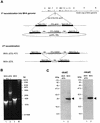Replication of modified vaccinia virus Ankara in primary chicken embryo fibroblasts requires expression of the interferon resistance gene E3L
- PMID: 12857909
- PMCID: PMC165266
- DOI: 10.1128/jvi.77.15.8394-8407.2003
Replication of modified vaccinia virus Ankara in primary chicken embryo fibroblasts requires expression of the interferon resistance gene E3L
Abstract
Highly attenuated modified vaccinia virus Ankara (MVA) serves as a candidate vaccine to immunize against infectious diseases and cancer. MVA was randomly obtained by serial growth in cultures of chicken embryo fibroblasts (CEF), resulting in the loss of substantial genomic information including many genes regulating virus-host interactions. The vaccinia virus interferon (IFN) resistance gene E3L is among the few conserved open reading frames encoding viral immune defense proteins. To investigate the relevance of E3L in the MVA life cycle, we generated the deletion mutant MVA-DeltaE3L. Surprisingly, we found that MVA-DeltaE3L had lost the ability to grow in CEF, which is the first finding of a vaccinia virus host range phenotype in this otherwise highly permissive cell culture. Reinsertion of E3L led to the generation of revertant virus MVA-E3rev and rescued productive replication in CEF. Nonproductive infection of CEF with MVA-DeltaE3L allowed viral DNA replication to occur but resulted in an abrupt inhibition of viral protein synthesis at late times. Under these nonpermissive conditions, CEF underwent apoptosis starting as early as 6 h after infection, as shown by DNA fragmentation, Hoechst staining, and caspase activation. Moreover, we detected high levels of active chicken alpha/beta IFN (IFN-alpha/beta) in supernatants of MVA-DeltaE3L-infected CEF, while moderate IFN quantities were found after MVA or MVA-E3rev infection and no IFN activity was present upon infection with wild-type vaccinia viruses. Interestingly, pretreatment of CEF with similar amounts of recombinant chicken IFN-alpha inhibited growth of vaccinia viruses, including MVA. We conclude that efficient propagation of MVA in CEF, the tissue culture system used for production of MVA-based vaccines, essentially requires conserved E3L gene function as an inhibitor of apoptosis and/or IFN induction.
Figures











Similar articles
-
E3L and F1L Gene Functions Modulate the Protective Capacity of Modified Vaccinia Virus Ankara Immunization in Murine Model of Human Smallpox.Viruses. 2018 Jan 4;10(1):21. doi: 10.3390/v10010021. Viruses. 2018. PMID: 29300297 Free PMC article.
-
Role of viral factor E3L in modified vaccinia virus ankara infection of human HeLa Cells: regulation of the virus life cycle and identification of differentially expressed host genes.J Virol. 2005 Feb;79(4):2584-96. doi: 10.1128/JVI.79.4.2584-2596.2005. J Virol. 2005. PMID: 15681458 Free PMC article.
-
Host range and cytopathogenicity of the highly attenuated MVA strain of vaccinia virus: propagation and generation of recombinant viruses in a nonhuman mammalian cell line.Virology. 1997 Nov 24;238(2):198-211. doi: 10.1006/viro.1997.8845. Virology. 1997. PMID: 9400593
-
Modified Vaccinia virus Ankara: innate immune activation and induction of cellular signalling.Vaccine. 2013 Sep 6;31(39):4231-4. doi: 10.1016/j.vaccine.2013.03.017. Epub 2013 Mar 21. Vaccine. 2013. PMID: 23523404 Review.
-
[Modified vaccinia virus ankara (MVA)--development as recombinant vaccine and prospects for use in veterinary medicine].Berl Munch Tierarztl Wochenschr. 2015 Nov-Dec;128(11-12):464-72. Berl Munch Tierarztl Wochenschr. 2015. PMID: 26697713 Review. German.
Cited by
-
E3L and F1L Gene Functions Modulate the Protective Capacity of Modified Vaccinia Virus Ankara Immunization in Murine Model of Human Smallpox.Viruses. 2018 Jan 4;10(1):21. doi: 10.3390/v10010021. Viruses. 2018. PMID: 29300297 Free PMC article.
-
Vaccinia virus subverts a mitochondrial antiviral signaling protein-dependent innate immune response in keratinocytes through its double-stranded RNA binding protein, E3.J Virol. 2008 Nov;82(21):10735-46. doi: 10.1128/JVI.01305-08. Epub 2008 Aug 20. J Virol. 2008. PMID: 18715932 Free PMC article.
-
Vaccinia Virus: Mechanisms Supporting Immune Evasion and Successful Long-Term Protective Immunity.Viruses. 2024 May 29;16(6):870. doi: 10.3390/v16060870. Viruses. 2024. PMID: 38932162 Free PMC article. Review.
-
Recombinant chimeric horsepox virus (TNX-801) is attenuated relative to vaccinia virus strains in both in vitro and in vivo models.mSphere. 2024 Dec 19;9(12):e0026524. doi: 10.1128/msphere.00265-24. Epub 2024 Nov 13. mSphere. 2024. PMID: 39535212 Free PMC article.
-
Cross-protective immunity against multiple influenza virus subtypes by a novel modified vaccinia Ankara (MVA) vectored vaccine in mice.Vaccine. 2013 Apr 3;31(14):1848-55. doi: 10.1016/j.vaccine.2013.01.038. Epub 2013 Feb 1. Vaccine. 2013. PMID: 23376279 Free PMC article.
References
-
- Amara, R. R., F. Villinger, J. D. Altman, S. L. Lydy, S. P. O'Neill, S. I. Staprans, D. C. Montefiori, Y. Xu, J. G. Herndon, L. S. Wyatt, M. A. Candido, N. L. Kozyr, P. L. Earl, J. M. Smith, H. L. Ma, B. D. Grimm, M. L. Hulsey, J. Miller, H. M. McClure, J. M. McNicholl, B. Moss, and H. L. Robinson. 2001. Control of a mucosal challenge and prevention of AIDS by a multiprotein DNA/MVA vaccine. Science 292:69-74. - PubMed
-
- Antoine, G., F. Scheiflinger, F. Dorner, and F. G. Falkner. 1998. The complete genomic sequence of the modified vaccinia Ankara strain: comparison with other orthopoxviruses. Virology 244:365-396. - PubMed
-
- Beattie, E., J. Tartaglia, and E. Paletti. 1991. Vaccinia virus-encoded eIF-2α homolog abrogates the antiviral effect of interferon. Virology 183:419-422. - PubMed
Publication types
MeSH terms
Substances
LinkOut - more resources
Full Text Sources
Other Literature Sources

